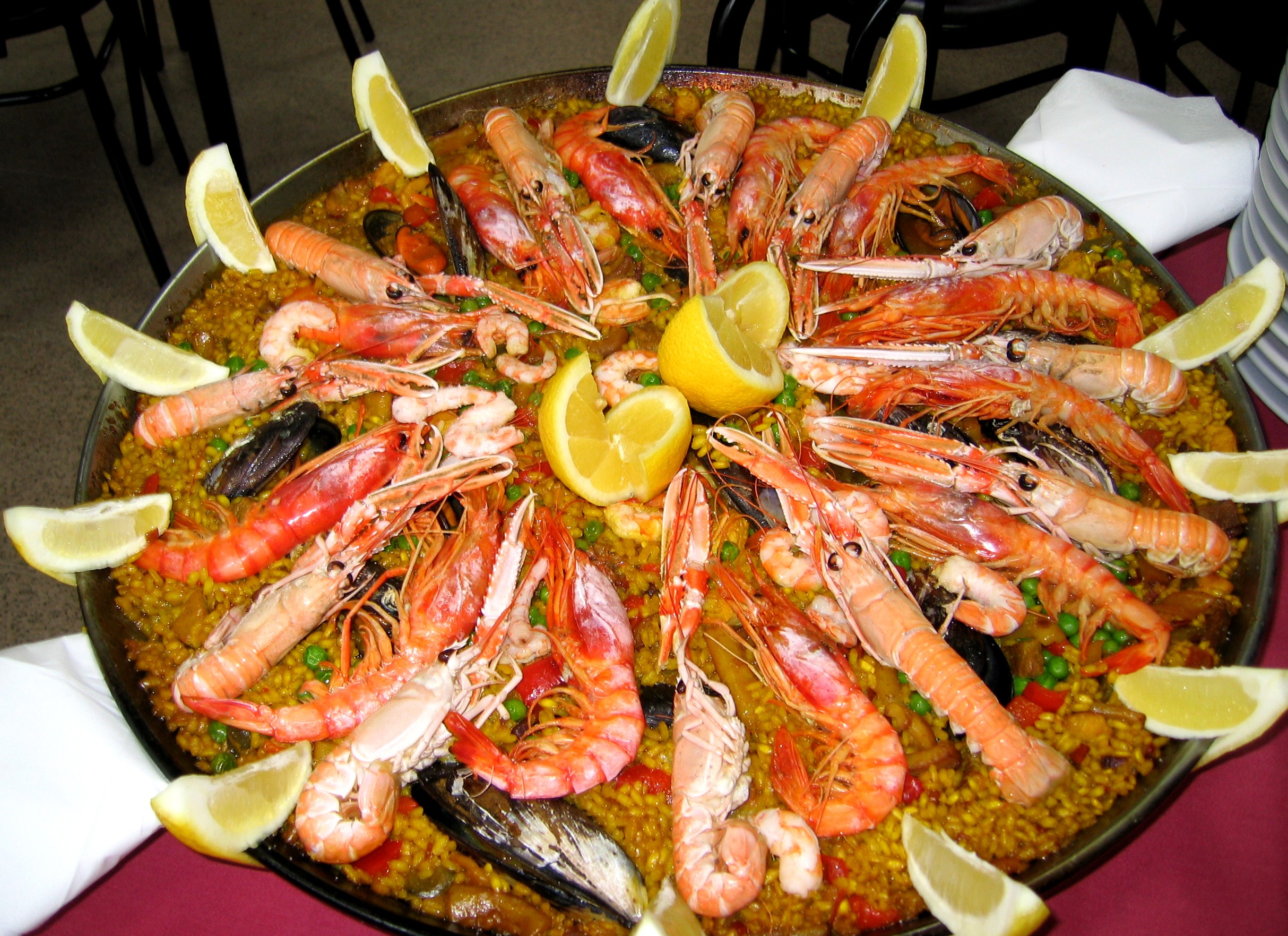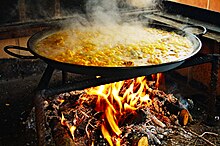Spanish delicacy
PAELLA

Paella is a Valencian rice dish with ancient roots that originated in its modern form in the mid-19th century near Albufera lagoon on the east coast of Spain adjacent to the city of Valencia
The Moors of Moorish Spain began rice cultivation around the 10th century. Consequently, residents of the Valencian region often made casseroles of rice, fish and spices for family gatherings and religious feasts, thus establishing the custom of eating rice in Spain. This led to rice becoming a staple by the 15th century. Afterwards, it became customary for cooks to combine rice with vegetables, beans and dry cod, providing an acceptable meal for Lent. Along Spain's eastern coast, rice was predominantly eaten with fish.
Spanish food historian Lourdes March notes that the dish "symbolizes the union and heritage of two important cultures, the Roman, which gives us the utensil and the Arab which brought us the basic food of humanity for centuries
Living standards rose with the sociological changes of the late 19th century in Spain, giving rise to gatherings and outings in the countryside. This led to a change in paella's ingredients as well, using instead rabbit, chicken, duck and sometimes snails. This dish became so popular that in 1840 a local Spanish newspaper first used the word paella to refer to the recipe rather than the pan.
The most widely used, complete ingredient list of this era was as follows: short-grain white rice, chicken, rabbit, snails (optional), duck (optional), butter beans, great northern beans, runner beans, artichoke (a substitute for runner beans in the winter), tomatoes, fresh rosemary, sweet paprika, saffron, garlic (optional), salt, olive oil and water. Poorer Valencians, however, sometimes used nothing more than snails for meat. Valencians insist that only these ingredients should go into making modern Valencian paella.
On the Mediterranean coast, Valencians used seafood instead of meat and beans to make paella. Valencians regard this recipe as authentic as well. In this recipe, the seafood is served in the shell. A variant on this is paella del senyoret which utilizes seafood without shells. Later, however, Spaniards living outside of Valencia combined seafood with meat from land animals and mixed paella was born. This paella is sometimes called "preparación barroca" (baroque preparation) due to the variety of ingredients and its final presentation.
During the 20th century, paella's popularity spread past Spain's borders. As other cultures set out to make paella, the dish invariably acquired regional influences. Consequently, paella recipes went from being relatively simple to including a wide variety of seafood, meat, sausage, (even chorizo)vegetables and many different seasonings. However, the most globally popular recipe is seafood paella.
Throughout non-Valencian Spain, mixed paella is very popular. Some restaurants in Spain (and many in the United States) that serve this mixed version, refer to it as Valencian paella. However, Valencians insist only the original two Valencian recipes are authentic. They generally view all others as inferior, not genuine or even grotesque.
Some recipes call for paella to be covered and left to settle for five or ten minutes after cooking.
This recipe is standardized because Valencians consider it traditional and very much part of their culture. Rice in Valencian paella is never braised in oil, as pilaf, though the paella made further southwest of Valencia often is.
Recipes for this dish vary somewhat, even in Valencia. Below is a recipe by Juanry Segui, a prominent Valencian chef.
There are countless mixed paella recipes. The following method is common to most of these. Seasoning depends greatly on individual preferences and regional influences. However, salt, saffron and garlic are almost always included.

Paella is a Valencian rice dish with ancient roots that originated in its modern form in the mid-19th century near Albufera lagoon on the east coast of Spain adjacent to the city of Valencia
The Moors of Moorish Spain began rice cultivation around the 10th century. Consequently, residents of the Valencian region often made casseroles of rice, fish and spices for family gatherings and religious feasts, thus establishing the custom of eating rice in Spain. This led to rice becoming a staple by the 15th century. Afterwards, it became customary for cooks to combine rice with vegetables, beans and dry cod, providing an acceptable meal for Lent. Along Spain's eastern coast, rice was predominantly eaten with fish.
Spanish food historian Lourdes March notes that the dish "symbolizes the union and heritage of two important cultures, the Roman, which gives us the utensil and the Arab which brought us the basic food of humanity for centuries
Valencian paella
On special occasions, 18th century Valencians used calderos to cook rice in the open air of their orchards near lake Albufera. Water vole meat was one of the main ingredients of early paellas, along with eel and butter beans. Novelist Vicente Blasco Ibáñez described the Valencian custom of eating water voles in Cañas y Barro (1902), a realistic novel about life among the fishermen and peasants near lake Albufera.Living standards rose with the sociological changes of the late 19th century in Spain, giving rise to gatherings and outings in the countryside. This led to a change in paella's ingredients as well, using instead rabbit, chicken, duck and sometimes snails. This dish became so popular that in 1840 a local Spanish newspaper first used the word paella to refer to the recipe rather than the pan.
The most widely used, complete ingredient list of this era was as follows: short-grain white rice, chicken, rabbit, snails (optional), duck (optional), butter beans, great northern beans, runner beans, artichoke (a substitute for runner beans in the winter), tomatoes, fresh rosemary, sweet paprika, saffron, garlic (optional), salt, olive oil and water. Poorer Valencians, however, sometimes used nothing more than snails for meat. Valencians insist that only these ingredients should go into making modern Valencian paella.
Seafood and mixed paella
On the Mediterranean coast, Valencians used seafood instead of meat and beans to make paella. Valencians regard this recipe as authentic as well. In this recipe, the seafood is served in the shell. A variant on this is paella del senyoret which utilizes seafood without shells. Later, however, Spaniards living outside of Valencia combined seafood with meat from land animals and mixed paella was born. This paella is sometimes called "preparación barroca" (baroque preparation) due to the variety of ingredients and its final presentation.
During the 20th century, paella's popularity spread past Spain's borders. As other cultures set out to make paella, the dish invariably acquired regional influences. Consequently, paella recipes went from being relatively simple to including a wide variety of seafood, meat, sausage, (even chorizo)vegetables and many different seasonings. However, the most globally popular recipe is seafood paella.
Throughout non-Valencian Spain, mixed paella is very popular. Some restaurants in Spain (and many in the United States) that serve this mixed version, refer to it as Valencian paella. However, Valencians insist only the original two Valencian recipes are authentic. They generally view all others as inferior, not genuine or even grotesque.
Basic cooking methods
According to tradition in Valencia, paella is cooked over an open fire, fueled by orange and pine branches along with pine cones. This produces an aromatic smoke which infuses the paella. Also, dinner guests traditionally eat directly out of the paellera.Some recipes call for paella to be covered and left to settle for five or ten minutes after cooking.
Valencian paella
- Heat oil in a paella.
- Sauté meat after seasoning with salt.
- Add green vegetables and sauté until soft.
- Add garlic (optional), grated tomatoes, beans and sauté.
- Add paprika and sauté.
- Add water, saffron (and/or food coloring), snails (optional) and rosemary.
- Boil to make broth and allow it to reduce by half.
- Remove the rosemary once flavour has infused or it starts to fall apart.
- Add rice and simmer until rice is cooked.
- Garnish with more fresh rosemary.
Seafood paella
- Make a seafood broth from shrimp heads, onions, garlic and bay leaves.
- Heat oil in a paellera.
- Add mussels. Cook until they open and then remove.
- Sauté Norway lobster and whole, deep-water rose shrimp. Then remove both the lobster and shrimp.
- Add chopped cuttlefish and sauté.
- Add shrimp tails and sauté.
- Add chunks of whitefish.
- Add garlic and sauté.
- Add grated tomato and sauté.
- Add rice and braise in sofrito.
- Add paprika and sauté.
- Add seafood broth and then saffron (and/or food coloring).
- Add salt to taste.
- Replace the deep-water rose shrimp, mussels and Norway lobster.
- Simmer until rice is cooked.
Mixed paella
Plate of paella with Aioli
- Make a broth from seafood, chicken, onions, garlic, bell peppers and bay leaf.
- Heat oil in a paellera.
- Sear red bell pepper strips and set aside.
- Sear crustaceans and set aside.
- Season meat lightly with salt and sauté meat until golden brown.
- Add onions, garlic and bell peppers. Sauté until vegetables are tender.
- Add grated tomatoes and sauté.
- Add dry seasonings except for salt.
- Add rice.
- Braise rice until covered with sofrito.
- Add broth.
- Add salt to taste.
- Add saffron (and/or food coloring) and mix well.
- Simmer until rice is almost cooked.
- Replace crustaceans.
- Continue simmering until rice and crustaceans are finished cooking.
- Garnish with seared red bell pepper strips.
Tags: Spain







Comments
Post a Comment